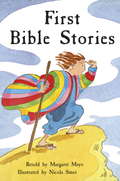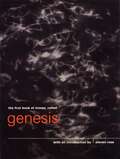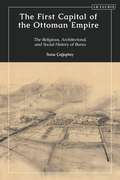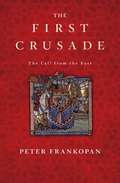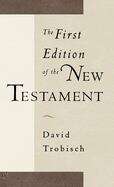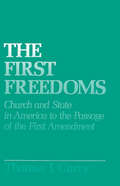- Table View
- List View
The First Bible of the Church: A Plea for the Septuagint (The Library of Hebrew Bible/Old Testament Studies)
by Mogens MüllerThe First Bible of the Church describes of the shape of the Jewish Bible at the time of the New Testament, with a special focus on the significance of the Greek translation, the Septuagint. The Jewish defence of the Septuagint version and its reception into the early Church makes it a representative of the Jewish Bible tradition fully on a par with the Hebrew Bible. This fact is especially important because the Septuagint is extensively used in the New Testament writings, whereby it-and not the Hebrew Bible (the Masoretic text)-is the most obvious candidate for the title of the first Bible of the Church.
First Bible Stories
by Margaret MayoChildren and their parents will enjoy meeting Adam and Eve and the sneaky snake; brave Daniel in the lions' den; Jonah and the enormous whale, and Joseph and his rough-tough brothers. These nine tales, full of lively characters, make the perfect introduction to Bible stories."Positively jaunty in tone, and Nicola Smee's friendly illustrations make this collection very accessible"- Parenting MagazineContents:How the World Was MadeThe Story of Adam and EveThe Story of the FloodJoseph and His Jealous BrothersClever Miriam, Moses and the PrincessThe Story of David and GoliathThe Story of Jonah and the Incredibly Enormous FishBrave Daniel's Story
The First Book of Adam and Eve
by Rutherford PlattThis book is a written history of what happened in the days of Adam and Eve after they were cast out of the garden. Although considered to be pseudepigraphic by some, it carries significant meaning and insight into events of that time.
The First Book of Moses, Called Genesis: The Bible (The Pocket Canons #1)
by Steven RoseGenesis covers some of the most famous stories of all time, including the garden of Eden, Noah's Ark and Cain and Abel. Using the emergence of the people of Israel as a starting point, it tells the story of the beginning of the world as ancient writers understood it. The text is introduced by Steven Rose.
The First Capital of the Ottoman Empire: The Religious, Architectural, and Social History of Bursa
by Suna CagaptayFrom 1326 to 1402, Bursa, known to the Byzantines as Prousa, served as the first capital of the Ottoman Empire. It retained its spiritual and commercial importance even after Edirne (Adrianople) in Thrace, and later Constantinople (Istanbul), functioned as Ottoman capitals. Yet, to date, no comprehensive study has been published on the city's role as the inaugural center of a great empire. In works by art and architectural historians, the city has often been portrayed as having a small or insignificant pre-Ottoman past, as if the Ottomans created the city from scratch. This couldn't be farther from the truth. In this book, rooted in the author's archaeological experience, Suna Çagaptay tells the story of the transition from a Byzantine Christian city to an Islamic Ottoman one, positing that Bursa was a multi-faith capital where we can see the religious plurality and modernity of the Ottoman world. The encounter between local and incoming forms, as this book shows, created a synthesis filled with nuance, texture, and meaning. Indeed, when one looks more closely and recognizes that the contributions of the past do not threaten the authenticity of the present, a richer and more accurate narrative of the city and its Ottoman accommodation emerges.
The First Capital of the Ottoman Empire: The Religious, Architectural, and Social History of Bursa
by Suna CagaptayFrom 1326 to 1402, Bursa, known to the Byzantines as Prousa, served as the first capital of the Ottoman Empire. It retained its spiritual and commercial importance even after Edirne (Adrianople) in Thrace, and later Constantinople (Istanbul), functioned as Ottoman capitals. Yet, to date, no comprehensive study has been published on the city's role as the inaugural center of a great empire. In works by art and architectural historians, the city has often been portrayed as having a small or insignificant pre-Ottoman past, as if the Ottomans created the city from scratch. This couldn't be farther from the truth. In this book, rooted in the author's archaeological experience, Suna Çagaptay tells the story of the transition from a Byzantine Christian city to an Islamic Ottoman one, positing that Bursa was a multi-faith capital where we can see the religious plurality and modernity of the Ottoman world. The encounter between local and incoming forms, as this book shows, created a synthesis filled with nuance, texture, and meaning. Indeed, when one looks more closely and recognizes that the contributions of the past do not threaten the authenticity of the present, a richer and more accurate narrative of the city and its Ottoman accommodation emerges.
The First Chapters: Dividing the Text of Scripture in Codex Vaticanus and Its Predecessors
by Charles E. HillThe First Chapters uncovers the origins of the first paragraph or chapter divisions in copies of the Christian Scriptures. Its focal point is the magnificent, fourth-century Codex Vaticanus (Vat.gr. 1209; B 03), perhaps the single most significant ancient manuscript of the Bible, and the oldest material witness to what may be the earliest set of numbered chapter divisions of the Bible. The First Chapters tells the history of textual division, starting from when copies of Greek literary works used virtually no spaces, marks, or other graphic techniques to assist the reader. It explores the origins of other numbering systems, like the better-known Eusebian Canons, but its theme is the first set of numbered chapters in Codex Vaticanus, what nineteenth-century textual critic Samuel P. Tregelles labelled the Capitulatio Vaticana. It demonstrates that these numbers were not, as most have claimed, late additions to the codex but belonged integrally to its original production. The First Chapters then breaks new ground by showing that the Capitulatio Vaticana has real precursors in some much earlier manuscripts. It thus casts light on a long, continuous tradition of scribally-placed, visual guides to the reading and interpreting of Scriptural books. Finally, The First Chapters exposes abundant new evidence that this early system for marking the sense-divisions of Scripture has played a much greater role in the history of exegesis than has previously been imaginable.
The First Chapters: Dividing the Text of Scripture in Codex Vaticanus and Its Predecessors
by Charles E. HillThe First Chapters uncovers the origins of the first paragraph or chapter divisions in copies of the Christian Scriptures. Its focal point is the magnificent, fourth-century Codex Vaticanus (Vat.gr. 1209; B 03), perhaps the single most significant ancient manuscript of the Bible, and the oldest material witness to what may be the earliest set of numbered chapter divisions of the Bible. The First Chapters tells the history of textual division, starting from when copies of Greek literary works used virtually no spaces, marks, or other graphic techniques to assist the reader. It explores the origins of other numbering systems, like the better-known Eusebian Canons, but its theme is the first set of numbered chapters in Codex Vaticanus, what nineteenth-century textual critic Samuel P. Tregelles labelled the Capitulatio Vaticana. It demonstrates that these numbers were not, as most have claimed, late additions to the codex but belonged integrally to its original production. The First Chapters then breaks new ground by showing that the Capitulatio Vaticana has real precursors in some much earlier manuscripts. It thus casts light on a long, continuous tradition of scribally-placed, visual guides to the reading and interpreting of Scriptural books. Finally, The First Chapters exposes abundant new evidence that this early system for marking the sense-divisions of Scripture has played a much greater role in the history of exegesis than has previously been imaginable.
The First Christian: The Encounters With Jesus Series:5
by Timothy KellerThe Gospels are full of encounters that made a profound impact on those who spoke with Jesus Christ. In the fifth part of his Encounters with Jesusseries, Timothy Keller, pastor of New York's Redeemer Presbyterian Church and New York Times-bestselling author of The Reason for God, shows how those encounters can still have a deep effect on us today. By examining an encounter between Jesus and Mary Magdalene, one of his most beloved disciples, Keller clarifies the Christian understanding of faith, and explains its role in answering the big questions of life.This and the other nine in the series make up the complete Encounters With Jesus: Unexpected Answers to Life's Biggest Questions.
The First Christian Communities, 32 - 380 CE: Quiet Christians, Visible Martyrs, and Compelling Texts
by Joyce E. SalisburyThis concise history of how the Christian Church grew between 32 and 380 focuses on the anonymous Christians who formed diverse congregations as they guided their communities through the age of the Apostles, violent martyrdoms, and to the establishment of the Roman Church. Readers will understand why people converted to Christianity in the first three centuries and learn about the rich diversity of the early church as people interpreted the new religion in different ways. This book explores how Christian interactions with the Roman empire led to violent persecutions and martyrdoms, and eventually the fourth-century establishment of the top-down Roman Church. Readers also become familiar with Christian texts during this period – some became Scripture and some were rejected, but all were written to make sense of the Jewish and Christian experience in the Roman Empire. These written memories shaped the future of the church. It also explores how early Christian lives were shaped by the religious rituals and preaching of their new and changing faith. In addition, maps, illustrations, and charts of Christian texts help tell this fascinating story. The First Christian Communities, 32 - 380 CE is an accessible and valuable resource suitable for students working on Christian history, and Roman and Late Antique social, political and religious history, as well as general readers who are interested in the origins of Christianity.
The First Christian Communities, 32 - 380 CE: Quiet Christians, Visible Martyrs, and Compelling Texts
by Joyce E. SalisburyThis concise history of how the Christian Church grew between 32 and 380 focuses on the anonymous Christians who formed diverse congregations as they guided their communities through the age of the Apostles, violent martyrdoms, and to the establishment of the Roman Church. Readers will understand why people converted to Christianity in the first three centuries and learn about the rich diversity of the early church as people interpreted the new religion in different ways. This book explores how Christian interactions with the Roman empire led to violent persecutions and martyrdoms, and eventually the fourth-century establishment of the top-down Roman Church. Readers also become familiar with Christian texts during this period – some became Scripture and some were rejected, but all were written to make sense of the Jewish and Christian experience in the Roman Empire. These written memories shaped the future of the church. It also explores how early Christian lives were shaped by the religious rituals and preaching of their new and changing faith. In addition, maps, illustrations, and charts of Christian texts help tell this fascinating story. The First Christian Communities, 32 - 380 CE is an accessible and valuable resource suitable for students working on Christian history, and Roman and Late Antique social, political and religious history, as well as general readers who are interested in the origins of Christianity.
The First Christmas and Other Bible Stories From the New Testament: New Testament - gift edition (Bumper Short Story Collections)
by Enid BlytonA beautiful cloth-bound gift edition containing 16 of the best-known New Testament stories retold for children, by Enid Blyton, one of the world's best-loved storytellers. The perfect Christmas gift.'Enid Blyton's retelling of Christ's own stories and the meaning of His time on Earth is full of love - Christ's love for us, our love for each other - and Enid's caring and timeless love for children everywhere' - from the introduction by Pam Rhodes.Enid Blyton has been delighting readers for more than seventy years. Find more retold religious stories in Noah's Ark and Other Bible Stories and The Land of Far Beyond. Enid's best-loved characters include Noddy the wooden boy, Timmy the dog from The Famous Five and the mischievous twins Pat and Isabel O'Sullivan from the much-loved boarding school series St Clare's. The stories in this collection previously appeared in magazines and anthologies from the 40s and 60s. Illustrated in black and white, the collection contains the following stories, which are episodes in the life of Christ:The First Christmas, The Shepherds in the Night, The Three Wise Men, The Angel's Warning, The Little Boy Jesus, Twelve Years Old, The Twelve Disciples, The Nobleman's Son, The Loaves and the Fishes, The Good Samaritan, The Boy Who Left Home, The Last Supper, The Capture of Jesus, The Story of Easter, Jesus on the Cross, Jesus Rises Again
The First Commentary On Mark: An Annotated Translation
by Michael CahillThis book is the first English translation of a text that Michael Cahill identifies as the first formal commentary on Mark's Gospel. Thought to have been written by an early seventh-century abbot, the commentary was for almost 1000 years attributed to St. Jerome and as such exercised incalculable influence on subsequent commentary. St. Thomas Aquinas drew on it freely in hisCatena Aurea, for example, as did the highly influential Counter-Reformation commentary of Cornelius a Lapide. Renaissance scholarship demoted the work to the pseudepigrapha of Jerome and it clearly lost status as a result. However, the contemporary recovery of interest in the commentary tradition ensures a welcome for the publication of this translation. Irrespective of authorship, the text is important in the history of biblical interpretation--it is the first commentary on Mark, and has had wide influence in the Latin west. It is written in the allegorical style, and attempts to provide an application of the gospel text to the practice of Christian discipleship. It is characterized by the use of other biblical texts, and through the use of bold face and italics in the translation, the reader is able to see the extent of quotation, paraphrase, and allusion. The extensive notes are designed to provide information on source material and on the author's technique. As the first Markan commentary this text holds a unique place in the history of biblical exegesis. This translation will make it available to scholars who do not read Latin, and will serve as a useful introduction to early and medieval Bible commentary, both in format and content.
The First Commentary on Mark: An Annotated Translation
by Michael CahillThis book is the first English translation of a text that Michael Cahill identifies as the first formal commentary on Mark's Gospel. Thought to have been written by an early seventh-century abbot, the commentary was for almost 1000 years attributed to St. Jerome and as such exercised incalculable influence on subsequent commentary. St. Thomas Aquinas drew on it freely in his Catena Aurea, for example, as did the highly influential Counter-Reformation commentary of Cornelius a Lapide. Renaissance scholarship demoted the work to the pseudepigrapha of Jerome and it clearly lost status as a result. However, the contemporary recovery of interest in the commentary tradition ensures a welcome for the publication of this translation. Irrespective of authorship, the text is important in the history of biblical interpretation--it is the first commentary on Mark, and has had wide influence in the Latin west. It is written in the allegorical style, and attempts to provide an application of the gospel text to the practice of Christian discipleship. It is characterized by the use of other biblical texts, and through the use of bold face and italics in the translation, the reader is able to see the extent of quotation, paraphrase, and allusion. The extensive notes are designed to provide information on source material and on the author's technique. As the first Markan commentary this text holds a unique place in the history of biblical exegesis. This translation will make it available to scholars who do not read Latin, and will serve as a useful introduction to early and medieval Bible commentary, both in format and content.
First Communion: Ritual, Church and Popular Religious Identity (Liturgy, Worship and Society Series)
by Peter McGrailOne of the most carefully prepared liturgies of any Roman Catholic parish's year is the celebration of 'First Communion'. This is the ritual by which seven- or eight -year-old children are admitted to the Eucharist for the first time. It attracts the largest congregations of any parish liturgy, and yet is frequently marked by tension and dissent within the parish community. The same ritual holds very different meanings for the various parties involved - clergy, parish schools, regularly communicating parishioners, and the first communicants and their families. The tensions arise from dissonance between the parties on such key issues as expected patterns of Church attendance, Catholic identity, dress and expenditure, and family formation. The relationships and discontinuities between popular and 'official' religion is at the heart of these tensions. They touch upon deep-seated anxieties concerning the future viability of the very structures and patterns of parish life during the current period of falling Church attendance and parish closures. For those within the Church who are concerned to understand and address the issues in its structural decline, this book will make sometimes uncomfortable but always stimulating reading. Peter McGrail examines the relationship between Church structures and popular religious identity, viewed through the lens of the first communion event. Drawing out hitherto unrecognised connections and significances for the future of the Catholic Church at local level, the insights into the decline of the parish as an institution present challenges to all with an interest in and concern for the future of the Church in the English-speaking world. Bringing to the fore the relationship and tensions between liturgy and Church structures, both historically and at the present time, this book offers academics and students alike extensive material for reflection and future development..
First Communion: Ritual, Church and Popular Religious Identity (Liturgy, Worship and Society Series)
by Peter McGrailOne of the most carefully prepared liturgies of any Roman Catholic parish's year is the celebration of 'First Communion'. This is the ritual by which seven- or eight -year-old children are admitted to the Eucharist for the first time. It attracts the largest congregations of any parish liturgy, and yet is frequently marked by tension and dissent within the parish community. The same ritual holds very different meanings for the various parties involved - clergy, parish schools, regularly communicating parishioners, and the first communicants and their families. The tensions arise from dissonance between the parties on such key issues as expected patterns of Church attendance, Catholic identity, dress and expenditure, and family formation. The relationships and discontinuities between popular and 'official' religion is at the heart of these tensions. They touch upon deep-seated anxieties concerning the future viability of the very structures and patterns of parish life during the current period of falling Church attendance and parish closures. For those within the Church who are concerned to understand and address the issues in its structural decline, this book will make sometimes uncomfortable but always stimulating reading. Peter McGrail examines the relationship between Church structures and popular religious identity, viewed through the lens of the first communion event. Drawing out hitherto unrecognised connections and significances for the future of the Catholic Church at local level, the insights into the decline of the parish as an institution present challenges to all with an interest in and concern for the future of the Church in the English-speaking world. Bringing to the fore the relationship and tensions between liturgy and Church structures, both historically and at the present time, this book offers academics and students alike extensive material for reflection and future development..
First Confession: A Sort of Memoir
by Chris PattenChris Patten was a cradle Catholic (hence First Confession), became on the most prominent Tory 'Wets' of the 1980s and 1990s, and went on to hold a series of prominent public offices - Chairman of the Conservative Party, the last Governor of Hong Kong, European Commissioner for External Affairs, Chancellor of Oxford University, Chairman of the BBC, advisor to the Pope - as he self-deprecatingly puts it 'a Grand Poo-bah, the Lord High Everything Else'. He writes with wry humour about his time in all these offices, taking us behind the scenes and showing us unexpected sides of many of the great figures of the day. No political writer is so purely enjoyable as Chris Patten.
The First Crusade: The Call from the East
by Peter FrankopanAccording to tradition, the First Crusade began at Pope Urban II’s instigation and culminated in July 1099, when western European knights liberated Jerusalem. But what if the First Crusade’s real catalyst lay far to the east of Rome? Countering nearly a millennium of scholarship, Peter Frankopan reveals the First Crusade’s untold history.
The First Crusade: The Call from the East
by Peter FrankopanAccording to tradition, the First Crusade began at Pope Urban II’s instigation and culminated in July 1099, when western European knights liberated Jerusalem. But what if the First Crusade’s real catalyst lay far to the east of Rome? Countering nearly a millennium of scholarship, Peter Frankopan reveals the First Crusade’s untold history.
The First Crusade: The Call from the East
by Peter Frankopan“The most significant contribution to rethinking the origins and course of the First Crusade for a generation.”—Mark Whittow, Times Literary Supplement“Filled with Byzantine intrigue, in every sense this book is important, compellingly revisionist and impressive. It refocuses the familiar western story through the eyes of the emperor of the east and fills in the missing piece of the puzzle of the Crusades.”—Simon Sebag Montefiore, author of Jerusalem: The Biography“Highly readable…its presentation of political machinations, compromises, and betrayals seems utterly convincing.”—Michael Dirda, Washington Post“A dazzling book, perfectly combining deep scholarship and easy readability. The most important addition to Crusading literature since Steven Runciman.”—John Julius Norwich, author of Byzantium“Fluent and dramatic…Frankopan rightly places the Emperor Alexios at the heart of the First Crusade, skillfully adding a dimension frequently missing from our understanding of this seminal event.”—Jonathan Phillips, author of Holy WarriorsIn 1096, an expedition of extraordinary scale and ambition set off from western Europe on a mass pilgrimage to Jerusalem. Three years later, after a journey that saw acute hardship, the most severe dangers, and thousands of casualties, the knights of the First Crusade found themselves storming the fortifications and capturing the Holy City. Against all odds, the expedition had returned Jerusalem to Christian hands.In this groundbreaking book, Peter Frankopan paints a vivid picture of this infamous confrontation between Christianity and Islam. Basing his account on long-ignored eastern sources, he gives a provocative and highly original explanation of the world-changing events that followed. The Vatican’s victory cemented papal power, while Constantinople, the heart of the still-vital Byzantine Empire, never recovered. Frankopan’s revolutionary work shows how the taking of Jerusalem set the stage for western Europe’s dominance and shaped the modern world.
First-Degree Incest and the Hebrew Bible: Sex in the Family (The Library of Hebrew Bible/Old Testament Studies #596)
by Johanna Stiebert'Incest' refers to illegal sexual relations between family members. Its precise contours, however, are culturally specific. Hence, an illegal incestuous union in one social context may be a legal close-kin union in another. First-degree sexual unions, between a parent and child, or between siblings, are most widely prohibited and abhorred. This book discusses all overt and covert first-degree incest relations in the Hebrew Bible and also probes the significance of gaps and what these imply about projected sexual and social values. As the dominant opinion on the origin of first-degree incest continues to be shaped, new voices such as those of queer and post-feminist criticism have joined the conversation. It navigates not only the incest laws of Leviticus and the narratives of Lot and his daughters and of Amnon and Tamar but pursues subtler intimations of first-degree sexual unions, such as between Adam and his (absent but arguably implied) mother, Haran and Terah's wife, Ham and Noah. In pursuing the psycho-social values that may be drawn from the Hebrew Bible regarding first-degree incest, this book will provide a thorough review of incest studies from the early 20th century onward and explain and assess the contribution of very recent critical approaches from queer and post-feminist perspectives.
First-Degree Incest and the Hebrew Bible: Sex in the Family (The Library of Hebrew Bible/Old Testament Studies #596)
by Johanna Stiebert'Incest' refers to illegal sexual relations between family members. Its precise contours, however, are culturally specific. Hence, an illegal incestuous union in one social context may be a legal close-kin union in another. First-degree sexual unions, between a parent and child, or between siblings, are most widely prohibited and abhorred. This book discusses all overt and covert first-degree incest relations in the Hebrew Bible and also probes the significance of gaps and what these imply about projected sexual and social values. As the dominant opinion on the origin of first-degree incest continues to be shaped, new voices such as those of queer and post-feminist criticism have joined the conversation. It navigates not only the incest laws of Leviticus and the narratives of Lot and his daughters and of Amnon and Tamar but pursues subtler intimations of first-degree sexual unions, such as between Adam and his (absent but arguably implied) mother, Haran and Terah's wife, Ham and Noah. In pursuing the psycho-social values that may be drawn from the Hebrew Bible regarding first-degree incest, this book will provide a thorough review of incest studies from the early 20th century onward and explain and assess the contribution of very recent critical approaches from queer and post-feminist perspectives.
The First Edition Of The New Testament: (pdf)
by David TrobischThe First Edition of the New Testament is a groundbreaking book that argues that the New Testament is not the product of a centuries-long process of development. Its history, David Trobisch finds, is the history of a book--an all Greek Christian bible--published as early as the second century C.E. and intended by its editors to be read as a whole. Trobisch claims that this bible achieved wide circulation and formed the basis of all surviving manuscripts of the New Testament.
The First Freedoms: Church and State in America to the Passage of the First Amendment
by Thomas J. CurryIs government forbidden to assist all religions equally, as the Supreme Court has held? Or does the First Amendment merely ban exclusive aid to one religion, as critics of the Court assert? The First Freedoms studies the church-state context of colonial and revolutionary America to present a bold new reading of the historical meaning of the religion clauses of the First Amendment. Synthesizing and interpreting a wealth of evidence from the founding of Virginia to the passage of the Bill of Rights, including everything published in America before 1791, Thomas Curry traces America's developing ideas on religious liberty and offers the most extensive investigation ever of the historical origins and background of the First Amendment's religion clauses.

